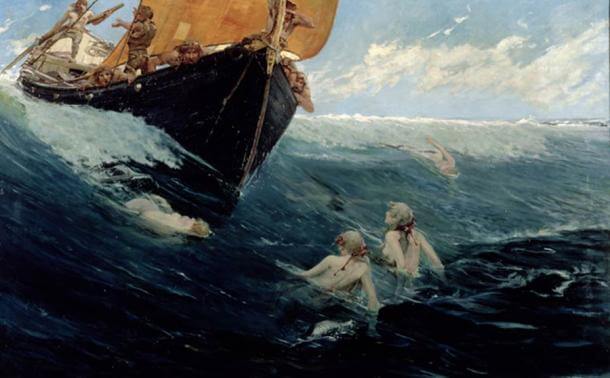
Abaddon
 26. 04. 2024
26. 04. 2024



 23. 09. 2021
23. 09. 2021

Mermaids have occupied our imagination for thousands of years. Charming aquatic creatures, half human and half fish. They have been seen in seas around the world and appear in literature and folklore in various cultures. According to legend, the beauty of mermaids attracted people who then drowned. But what if these supposedly mythical ghosts were actually inspired by a real health anomaly?
The consciousness of the mermaid (goddess Atargatis) originated in ancient Assyria, now northern Syria, and later spread to Greece and Rome. In legend, Atargatis transforms into a half-human and half-fish creature after drowning in shame for accidentally killing her human lover. In other cases, however, Atargatis is the goddess of fertility, who in Ascalon is associated with the goddess with a fish body. It is believed that the worship of Atargatis and Ascalona eventually merged into one, leading to the description of one mermaid goddess.

In legends and folklore, mermaids have been adored throughout history and at the same time everyone has feared them.
Throughout history, mermaids have been associated with dangerous events in European, African and Asian culture, including floods, storms, shipwrecks and drowning. Homer called them sirens in the Odyssey, claiming they had lured sailors to their deaths. They were depicted in Etruscan statues, Greek epics and bas-reliefs in Roman tombs. In 1493, Christopher Columbus announced that he had seen three mermaids near Haiti on his way to the Caribbean. In his logbook, Columbus wrote, "They are not as beautiful as they are painted, although to some extent they look like a human face."

Illustration of Atargatis, the first recorded mermaid, on the reverse of a coin of Demetrius III, King of Syria from 96-87 BC
Today, scientists claim that his description is in fact the first written record of an observation of a manatee, a marine mammal he did not know. These giant sea cows were now classified as Sirenia, named after the sirens of Greek mythology.
But what if the idea of a mermaid came about because of a health complication? Sirenomelia, named after the mythical Greek sirens, and also known as "mermaid syndrome", is a rare and fatal birth defect characterized by a fusion of the lower limbs. As a result, the limbs grow together and resemble a fish tail - which leads some to question whether ancient cases of this condition may have influenced the legends of the past. For example, it is known that ancient descriptions of sea monsters come from the observation of species unknown at the time, such as whales, giant octopuses and walruses, which were rarely seen and little understood.
Historical doctor Lindsey Fitzharris, after looking back at references to health in historical texts, published an article about the disturbing mermaid disorder on her blog The Chirurgeon's Apprentice. Modern Sirenomelia Survivors in an article published in the Journal of Clinical Neonatology, Kshirsagar et. explains that sirenomelia occurs when the umbilical cord passes only the amount of blood for one limb. Such an incidence is extremely rare, 0,8-1 cases / 100 births. Children with this physical disability live only a few days due to serious problems. However, with the development of surgical techniques, some children have been allowed to spend at least a few years or decades of life.
One of the most famous girls who have lived with this disorder for several years is Tiffany Yorks from Florida, USA. When she was a year old, she underwent surgery to separate her legs. Tiffany then lived to be 27. Although she had big mobility problems.
Shiloh Pepin she became famous due to her condition, especially after participating in a TLC documentary that followed her and her family. Shiloh Jade Pepin was born in Maine, United States. Her body was fused from the waist down and she had no genitals or anus. The family decided not to separate her joined legs. Unfortunately, she died at the age of 10.
The other girl was Milagros Cerron, whose first name translates as "miracle". Friends and family affectionately referred to her as the "little mermaid." In 2006, a team of specialists successfully separated her legs. She lived a full and active life, but unfortunately her condition required further surgery. It was necessary to support kidney function, digestion and the urogenital system. Unfortunately, the girl died at the age of 15 of kidney failure.
Whether this disorder has affected the reputation of the mermaid is not and probably will never really be clear. But the resemblance to the famous mermaid could at least partially help the children cope with the adversity of their fate.
A mixture of oils that helps with colds and flu. Contributes to improved immunity (lemon, lemongrass, thyme).